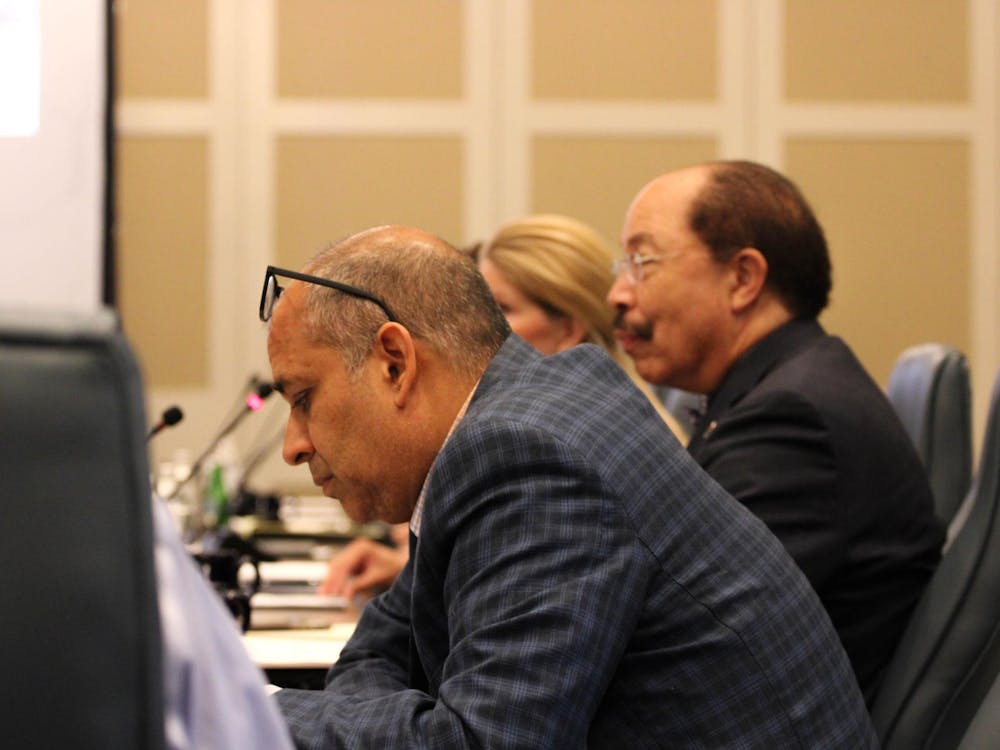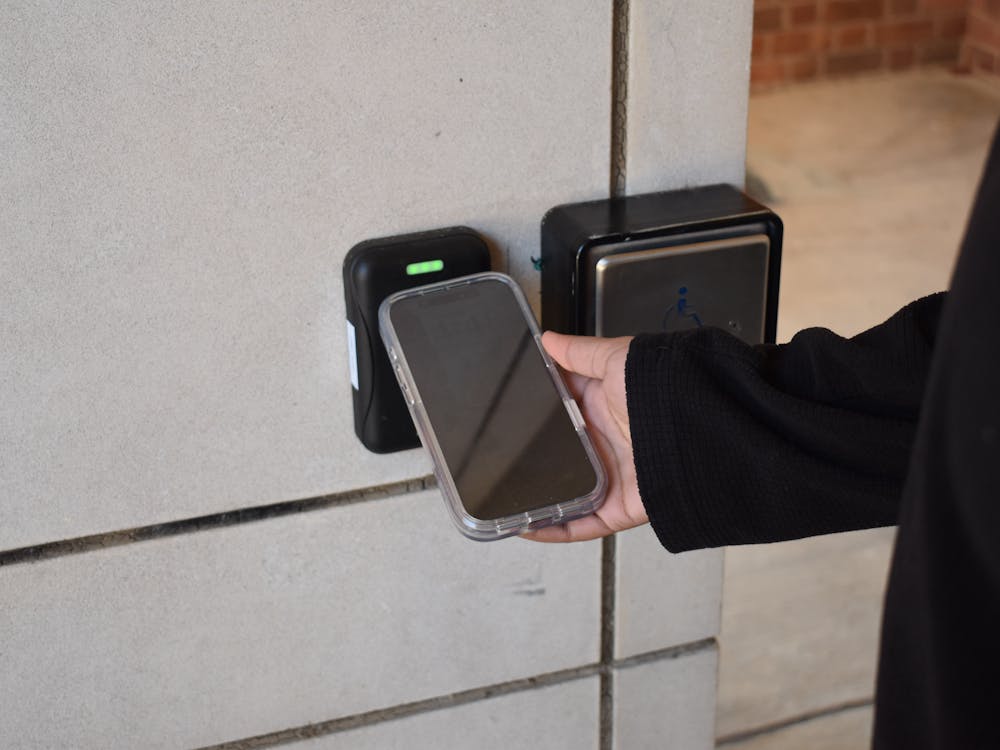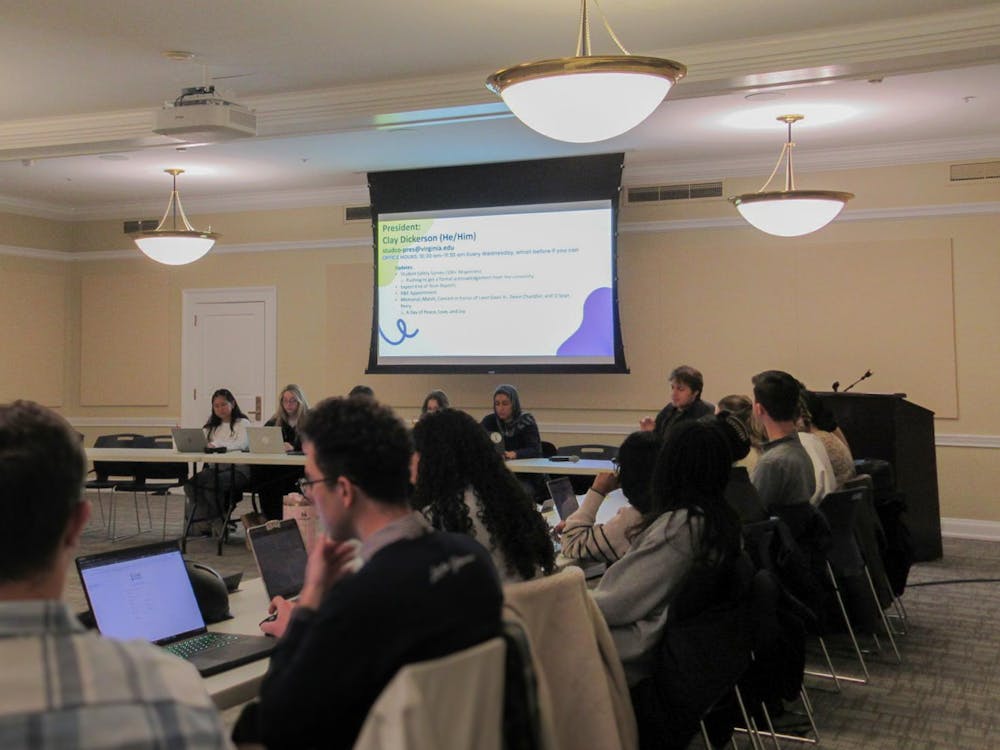Lea en español
The Board of Visitors’ Buildings and Grounds Committee approved the rededication of the Frank Hume Memorial, per a recommendation made by the Naming and Memorials Committee, during its meeting Friday afternoon. The committee also provided updates on the future of the George Rogers Clark statue, which will be removed by the end of the summer, and the near-completed construction of the new Student Health and Wellness Center.
The Hume Memorial Wall was erected in 1938 in honor of Frank Hume — a Confederate soldier who served in the Virginia House of Delegates for two terms after the Civil War. The memorial wall was funded by Hume’s sons after his death, though Frank Hume himself had no discernible connection with the University. The inscription on the wall refers to Hume as a “devoted Virginian who served his native state in Civil War and Legislative Hall.”
The Board officially voted to either remove or rededicate the memorial last fall. In February, the University created the Naming and Memorials Committee to examine and provide recommendations on the names and contextualization of statues, memorials and buildings on Grounds.
The committee previously recommended a digital contextualization of memorials across Grounds, which the Board approved in April. This digital contextualization will permit students, visitors and community members to develop an “informed perspective” on the University’s various statues and memorials, according to the committee. Suggested digital methods include placing QR codes near statues and memorials, though students have critiqued these methods as “inadequate.”
The committee’s official recommendation on the Frank Hume Memorial is to remove the inscription on the wall and replace it with blocks of a contrasting color, to refer to the memorial as the Whispering Wall and include the history of the memorial — and its Confederate roots — in the digital contextualization. The memorial has been called the Whispering Wall due to its unique ability to transmit sound from one side of the wall to the other.
Rather than replacing the inscription with blocks of the same color, the Naming and Memorials Committee noted that contrasting blocks will “mark the permanent change that has been made to [the] structure.”
“Our aim, then, in making this recommendation is neither to erase history nor to change it, but to enliven present and future generations ... to the circumstances under which a significant feature of the built environment on our Grounds was created and named,” the recommendation said.
The estimated cost of the replacement of the blocks on the wall is $430,000 according to the recommendation, but the committee noted that removal of the memorial and necessary modifications to its site would cost upwards of $1 million.
According to the recommendation, the committee made its decision based on research, consultation and community feedback, including a community comment feature on its website and a public listening session that was held in April. During the listening session, over 20 community members, students and faculty called for the removal of the memorial in its entirety, calling it “appalling” and a “glorification” of Hume’s contributions to the Confederacy.
The memorial was found vandalized twice in the same week in April. The University covered and fenced off the area and investigated both incidents.
In February, the Minority Rights Coalition — an alliance of seven student organizations focused on supporting students of marginalized identities — launched a petition and letter campaign calling for the removal of the Memorial in its entirety. The push was led by Abena Appiah-Ofori, incoming chair of the MRC and third-year College student, who co-authored a different petition to remove the wall that was sent by University President Jim Ryan to the racial equity task force.
“Devoting the same structure that has been erected for nearly a century to some other cause or person is not enough of an adjustment to denounce a treacherous history of violence and exploitation advocated for by the Confederacy,” the MRC petition read. “White supremacy is upheld as long as the memorial is still intact.”
The Virginia Art and Architecture Review Board — an advisory board which reviews modifications of all state-owned properties — will review the Board’s resolution to alter the memorial. The design, color and placement of the new blocks will be decided among Raucher and the chairs of the Naming Committee and Buildings and Grounds Committee.
After discussion of the Whispering Wall, University Architect Alice Raucher presented the master plan for the redevelopment of Ivy Gardens Apartments, an area located nearby the Darden School of Business, Miller Center and Center for Politics in high demand by graduate students for housing.
The plan includes suggestions for improved pedestrian and vehicular access, the possibility for construction of a new residential community of townhomes and the potential for new academic, social and retail spaces.
According to Raucher, the plan is only a “footprint” for the future of the Ivy Gardens area — there is not yet a timeline for the development nor a determined capital plan for specific buildings.
Colette Sheehy, senior vice president for operations and state government relations, then presented the revised major capital plan, which includes new projects such as the Karsh Institute of Democracy — an institution dedicated to the teaching and promotion of democracy made possible by a $50 million donation from the Karsh family, who was inspired to create the institute because of its own experience with democracy and public education. The University will match the donation for a total of a $100 million investment. Part of the funding will go towards the construction of a building on the Emmett-Ivy corridor, to be completed within the next six months.
Sheehy noted that the pandemic has brought rising commodity and material prices, which can make construction more expensive, but that the Committee is aware of these concerns in terms of future projects.
“We regularly re-estimate with our cost estimators the projects that we have in the queue as we proceed through the design and schematics,” Sheehy said.
Sheehy then provided an update on the future of the George Rogers Clark statue. The Board voted last fall to remove the statue, which is currently located by the Corner. The statue — which portrays Clark on horseback, towering over three Native Americans with an inscription reading “Conqueror of the Northwest” — was the site of a public demonstration in September and local activists have called for the establishment of a University Native American Foundation and the construction of an Indigenous Cultural Center in the space where the statue is located.
According to Sheehy, the statue will be removed by the end of the summer, a project that will cost an estimated $400,000. Step two of the plan will include engagement with the indigenous community before a final decision is made concerning the relocation of the statue and the future of the site. There is no current timeline for this second step.
Sheehy gave an update on the University’s sustainability plan, including their response to Governor Northam’s Executive Order 77, which requires Virginia colleges, universities and state agencies to phase out the use, sale and distribution of single-use plastics except for safety and medical reasons by 2025.
The meeting concluded with a short update on the construction of the new Student Health and Wellness Center, which began construction in 2019 and is located on the south end of Brandon Avenue. The center, designed with the goal of boosting the overall health and wellness of students through expanding programming and services, is now 48 days away from opening Aug. 11.

![<p>Rather than replacing the inscription with blocks of the same color, the Naming and Memorials Committee noted that contrasting blocks will “mark the permanent change that has been made to [the] structure.”</p>](https://snworksceo.imgix.net/cav/6c7e10a3-467c-49dc-ae23-eb0cabf16d60.sized-1000x1000.png?w=1000)





